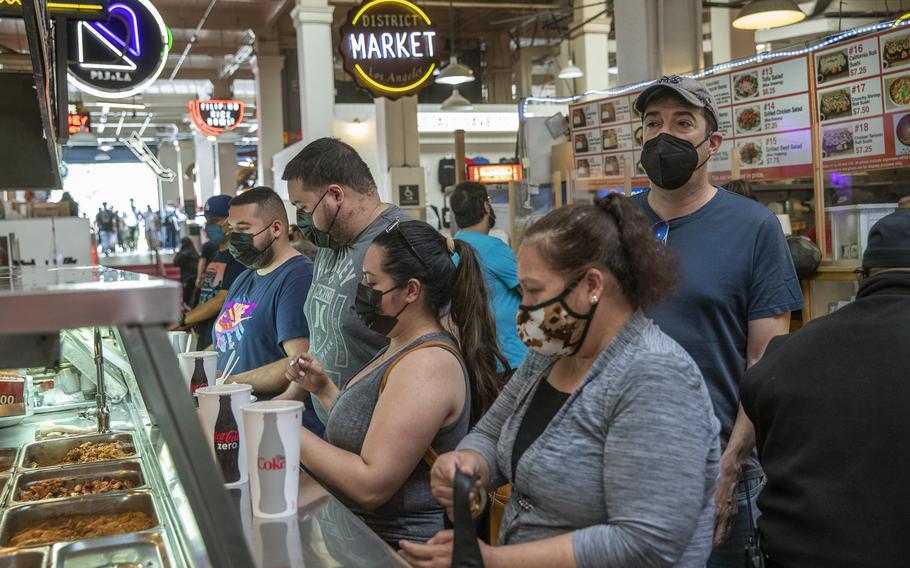Coronavirus
Masking rules are easing in California, but it’s complicated
Los Angeles Times February 24, 2022

Customers wait in line to order Mexican food inside the Grand Central Market on Broadway in downtown Los Angeles. (Mel Melcon, Los Angeles Times/TNS)
Stars and Stripes is making stories on the coronavirus pandemic available free of charge. See more stories here. Sign up for our daily coronavirus newsletter here. Please support our journalism with a subscription.
LOS ANGELES (Tribune News Service) — As omicron fades, communities across California are continuing to ease masking rules.
But that does not mean face coverings will suddenly disappear in public indoor spaces. Moreover, many health officials say it still makes sense to wear masks inside, even when there is no longer a mandate, because they offer strong protection.
Health officials announced Wednesday that fully vaccinated individuals will be able to shed their masks indoors at Los Angeles County establishments that screen the vaccination status of visitors.
Santa Clara County said it was close to lifting its mandate as well.
“We’re very encouraged that we’re coming out of this omicron surge,” said Dr. Sara Cody, the Santa Clara County public health director and health officer. “We are all looking forward to a time where we can remove our masks and feel safe.”
Santa Clara County is one of several in California to retain a universal indoor mask mandate. Los Angeles and Mendocino counties and the city of Palm Springs have also kept their mandates.
Here’s what to expect:
Los Angeles County
In L.A. County, the revised rules — which take effect at 12:01 a.m. Friday — represent a significant relaxation of the county’s universal indoor mask mandate, which has been in place since July.
According to the new county rules, businesses interested in relaxing face covering requirements will have two choices: Make masks optional for customers only, or for both customers and employees.
For the latter, workers and patrons alike would need to show proof of full vaccination or a recent negative coronavirus test to enter, and could unmask inside only if they’re fully vaccinated. Those who aren’t fully vaccinated would still be allowed in with a negative test result, but would need to keep their masks on.
Should a business elect to go the customer-only route, patrons would be subject to the same vaccine-or-test verification requirement, but workers would not.
State and federal masking requirements will still be in effect, mandating face coverings in a number of limited places, such as in healthcare settings, indoor K-12 schools and childcare facilities, and public transportation.
Schools
California officials on Monday are expected to announce a date to lift the indoor mask order in K-12 schools, although counties and schools will have the option to keep their own orders in place if they choose.
Dr. Mark Ghaly, the state’s health and human services secretary, said earlier this month that the decision won’t hinge on any one particular metric or threshold but, rather, on an overall picture — including the trend lines for coronavirus cases, hospitalizations and vaccinations, as well as how the pandemic is playing out elsewhere in the nation and across the globe.
Ghaly expressed optimism that the state will be able to alter its masking rules soon.
“Masking requirements were never put in place to be there forever,” he said. “It’s not a question of if; it’s a question of when.”
A poll conducted this month by the Institute of Governmental Studies at UC Berkeley and co-sponsored by the L.A. Times found nearly two-thirds of California voters, including a majority of parents, support mask and vaccine mandates in K-12 schools.
The results of the early February poll of nearly 9,000 voters suggest continued broad support for policies aimed at reducing the spread of the coronavirus in schools, even as protests against mask and vaccine mandates garner attention in school districts across the state.
Caveats
Even with L.A. County‘s new rules, it’s likely that masks will continue to be a part of life at indoor public places.
The rules that partially ease the indoor mask order could ultimately prove too complicated or resource-intensive to implement for businesses such as supermarkets and malls. But they may be easier at shops that are already required to check for proof of vaccination.
Moreover, no matter how state or local governments ease mask orders, businesses still can retain their own rules, and officials are still strongly recommending the public continue to wear face coverings in indoor public spaces.
A recent study by scientists at the University of California, Berkeley and the California Department of Public Health illustrated the effectiveness of masks in preventing coronavirus infection.
The study, published by the Centers for Disease Control and Prevention, found that those who always wear a mask indoors are less likely to test positive for the coronavirus compared with those who didn’t routinely wear masks.
Those who wore N95 or KN95 masks in public indoor settings had an 83% lower chance of testing positive, and those who wore surgical masks had a 66% lower chance.
Dr. Clayton Chau, director of the Orange County Health Care Agency and the county’s health officer, said he wears a mask both in indoor public places and in crowded outdoor settings as further protection against a breakthrough infection. He said he wants to avoid getting infected to protect his 86-year-old mother, who is fully vaccinated and boosted but has a weakened immune system.
©2022 Los Angeles Times.
Visit at latimes.com.
Distributed by Tribune Content Agency, LLC.